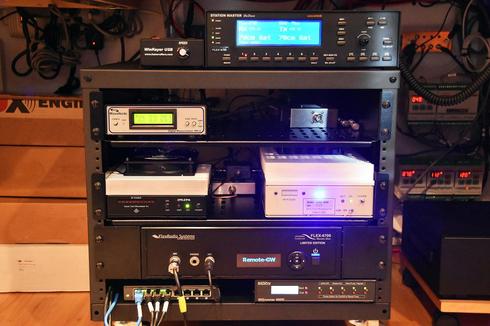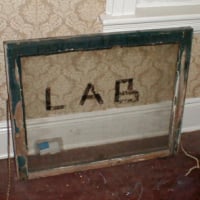Welcome to the FlexRadio Community! Please review the new Community Rules and other important new Community information on the Message Board.
Need the latest SmartSDR or 4O3A Genius Product Software?
SmartSDR v4.1.3 | SmartSDR v4.1.3 Release Notes
SmartSDR v3.10.15 | SmartSDR v3.10.15 Release Notes
The latest 4O3A Genius Product Software and Firmware
SmartSDR v4.1.3 | SmartSDR v4.1.3 Release Notes
SmartSDR v3.10.15 | SmartSDR v3.10.15 Release Notes
The latest 4O3A Genius Product Software and Firmware
If you are having a problem, please refer to the product documentation or check the Help Center for known solutions.
Need technical support from FlexRadio? It's as simple as Creating a HelpDesk ticket.
Need technical support from FlexRadio? It's as simple as Creating a HelpDesk ticket.
Flex SDR For Satellite Operations - Adding Transverters and an LPDA
Fred, AB1OC
Member ✭✭

Flex 6700 Remote Operating GW with Satellite Capability
We've been working on our Flex 6700-based Remote Gateway to add remote LEO Satellite operations capabilities. The hardware and associated configuration work on this project are complete and we are working on custom software that uses the FlexLib API to enable remote satellite operation via MacDoppler. I wanted to post a few links to articles about the project in hopes that others might find some of the ideas, information, and learnings useful.
- Flex SDR-based Satellite Station
- Adding L-Band Uplinks and Some New Software for MacDoppler
- Flex SDR-base Remote Operating Gateway Series
Fred, AB1OC
3
Comments
-
Awesome!! I love it. Thanks for sharing.
1 -
Great article! Awesome station! I'm considering moving my satellite operations from my Flex 5000 to my 6700 so your info is being taken in with great interest on this end!0
-
FB Paul. Let me know if you have any questions about the setup. The documentation on how to go about adding Transverters, etc. to the Flex Radios is a bit sketchy in spots. Hopefully, the blog posts will help some folks get through the process smoothly. One of the things that are tricky is understanding how SmartSDR controls some elements of the 2m LPDA. For example, the documentation is sketchy on the use of an external preamp which is powered by the LPDA. All of these features are working well here but it was a journey in spots to get there.
0 -
Fred,
I love your setup and it is very similar to mine. Pictures here: https://www.qrz.com/db/W4AX I did something very similar.
I have since revised the station to include L band plus I have changed to two 1 X 12 high isolation BNC relays for switching RX and TX to various transverters. My station will work 146, 220, 440, 902, and 1096 MHz plus all HF bands 160M - 6M.
I'll be pleased to try and answer any questions.
73,
Mack
W4AX
Alpha Team
1 -
Working on very similar concept here. See photos at https://www.qrz.com/db/K0JM Thanks for the links.0
-
Fred
Looks Great! Well done. Great documentation.
Two questions.
1- Can your Green Herron based Linux on a Rasberry Pi rotor program interface to SatPC32? If yes, what is the best choice for the protocol to use?
2- Any progress on the Flex Smart SDR / MacDoppler interface? Out of the box, I could control one VFO but not two VFOs using CAT / Smart SDR. I was able to use DogPark for two VFOs but preferred the Smart SDR interface.
Alan
WA9WUD0 -
Hello Alan,
Here are some thoughts on your questions:
1-The interface to the Green Heron/Raspberry Pi combination uses UDP messages sent by MacDoppler to control the rotator(s). The MacDoppler UDP messages are in an ASCII format and are easy to decode. Based upon a quick look, it does not appear that PCSat32 can generated UDP formatted messages of the same type. I notice that several other rotator controller manufacturers support some for of UDP message-based control so perhaps someone has done a compatible driver for PCSat32. If you find one, please let us know here.
2-I am making good progress on a program called FlexBridge. FlexBridge runs on a windows PC and uses the FlexLIB API to control both SmartSDR and an Az/El rotator. MacDoppler control of SmartSDR via FlexBridge is completed and working. See the following link for a preview of this (the screenshots of FlexBridge and SmartSDR are near the bottom of the post). With FlexBridge, MacDoppler can configure and control the VFOs on the Flex 6700/SmartSDR combination including setting PL Tones and Duplex operation for modes like APRS packet. I am currently working on some additions to enable FlexBridge to also run up to 3 sets of Rotators using the MacDoppler tracking data. When these enhancements are complete, the Green Heron rotator controllers here will connect directly to the PC that runs FlexBridge and controls the radio. Multiple rotators will enable MacDoppler to support both Satellite and EME operation here as these antennas are on different towers. I am planning support for any rotator system which uses the DCU-1 protocol. FlexBridge will include modes for Azimuth-only rotators, Az/El systems with a single controller, and Az/El systems using multiple controllers (including the Green Heron RT-21 Az/El).
Here's a screenshot of the current in-progress version of FlexBridge:
FlexBridge has a database that includes the transponder BW and other data for supported satellites. This enables FlexBridge to set the panadapter width in SmartSDR or on the Maestro to match the current satellite's passband. The satellite database will also be used to select the rotator system to use to track individual satellites or the Moon for EME.
Obviously, FlexBridge is designed to support the specific use case of MacDoppler running on a Mac to control the Flex Radio system running on a PC. I prefer MacDoppler because it has a modern interface and it does a good job of exposing radio control and tracking data via its generic and simple UDP ASCII interface.
We do quite a few demos of satellites in schools and other public venues here. I am planning to use the FlexBridge/MacDoppler combination along with a Maestro to enable remote operation of the satellite station here via the Internet. The idea is that the remote will only require a Mac laptop running MacDoppler and a Maestro as the Flex Radio client. A PC in the shack will be running FlexBridge and will handle the control. The interface to the remote will be via a VPN connection and the SmartLink in the case of the Maestro.
I hope this helps clarify things.
Fred, AB1OC
0 -
Fred
I like it.
I will give Flex Bridge a try. Should I wait for your twinks or give it a go now?
Asked and answered. Went back to your website and noted you are not yet providing a link for download.
What is the best way to know when it will be available for a test drive? Can't wait.
Alan
a.alan.blind@gmail.com
WA9WUD
0 -
Hi Alan,
I am still at the Alpha stage so you'll need to wait for a Beta. I would guess this might be a month or so out. I need to finish the R&D and operate with the completed SW for a while before I turn it loose for others to use.
Fred1 -
W0DHB has also written a Flex satellite utility, FlexSatPC, that links SatPC32, Log4OM, and SSDR to integrate tracking and logging. It was written up in a couple different articles in the AMSAT Journal, and is quite well developed (version 8 now). It's very slick, once set up. It's for use with Windows. Contact him directly about access.0
-
I use Dave’s software and it super well integrated with the FlexRadio and SSDR. I highly recommend it! 73, Mack W4AX Alpha Team1
Leave a Comment
Categories
- All Categories
- 381 Community Topics
- 2.1K New Ideas
- 633 The Flea Market
- 8.3K Software
- 129 SmartSDR+
- 6.4K SmartSDR for Windows
- 185 SmartSDR for Maestro and M models
- 430 SmartSDR for Mac
- 272 SmartSDR for iOS
- 259 SmartSDR CAT
- 195 DAX
- 382 SmartSDR API
- 9.4K Radios and Accessories
- 40 Aurora
- 265 FLEX-8000 Signature Series
- 7.2K FLEX-6000 Signature Series
- 955 Maestro
- 56 FlexControl
- 866 FLEX Series (Legacy) Radios
- 929 Genius Products
- 464 Power Genius XL Amplifier
- 340 Tuner Genius XL
- 125 Antenna Genius
- 297 Shack Infrastructure
- 209 Networking
- 461 Remote Operation (SmartLink)
- 144 Contesting
- 788 Peripherals & Station Integration
- 140 Amateur Radio Interests
- 1K Third-Party Software


